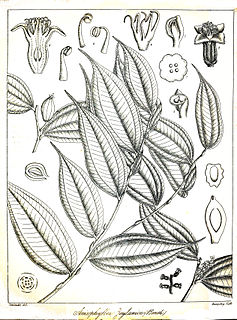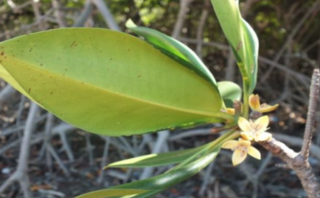Alangium nobile is a tree in the dogwood family Cornaceae. The specific epithet nobile is from the Latin meaning "noble" or "distinguished", likely referring to the growth habit.

Anisophyllea is a genus of plant in the family Anisophylleaceae. The generic name is from the Greek meaning "unequal leaf", referring to the dimorphism of the leaves.
Anisophyllea beccariana is a tree of tropical Asia in the family Anisophylleaceae. It is named for the Italian botanist Odoardo Beccari.
Anisophyllea chartacea is a tree of Borneo in the family Anisophylleaceae. The specific epithet chartacea is from the Latin meaning "papery", referring to the leaves.
Anisophyllea disticha is a plant of tropical Asia in the family Anisophylleaceae. The specific epithet disticha is from the Latin meaning "2-ranked", referring to the leaf arrangement.
Anisophyllea ferruginea is a tree of Borneo in the family Anisophylleaceae. The specific epithet ferruginea is from the Latin meaning "rust-coloured", referring to the leaf hairs.
Anisophyllea globosa is a tree of Borneo in the family Anisophylleaceae. The specific epithet globosa is from the Latin meaning "round", referring to the fruits.
Anisophyllea impressinervia is a tree of Borneo in the family Anisophylleaceae. The specific epithet impressinervia is from the Latin meaning "sunken veins", referring to the leaf veins.
Anisophyllea nitida is a tree of Borneo in the family Anisophylleaceae. The specific epithet nitida is from the Latin meaning "polished", referring to the shiny appearance of the upper leaf surface.
Brackenridgea palustris is a tree in the family Ochnaceae. The specific epithet palustris is from the Latin meaning "swampy", referring to the species' habitat.
Canarium littorale is a tree found in tropical Asia and is a member of the incense tree family Burseraceae. The specific epithet littorale is from the Latin meaning "of the seashore", referring to its habitat.
Canarium patentinervium is a tree of tropical Asia in the incense tree family Burseraceae. The specific epithet patentinervium is from the Latin meaning "spreading nerves", referring to the leaf veins.
Canarium pseudopatentinervium is a plant in the incense tree family Burseraceae. The specific epithet pseudopatentinervium is from the Latin meaning "false patentinervium", referring to the species' resemblance to Canarium patentinervium.
Canarium pseudopimela is a tree of Borneo in the incense tree family Burseraceae. The specific epithet pseudopimela is from the Latin meaning "false pimela", referring to the species' resemblance to Canarium pimela.
Canarium sarawakanum is a tree of Borneo in the incense tree family Burseraceae. The specific epithet sarawakanum is from the Latin, referring to the species being native to Sarawak.
Cassine viburnifolia is a mangrove plant of tropical Asia in the staff vine family Celastraceae. The specific epithet viburnifolia refers to how the plant's leaves resemble those of the genus Viburnum.
Perrottetia alpestris subsp. philippinensis is a subspecies of Perrottetia alpestris. It is a plant in the family Dipentodontaceae, sometimes classified in the family Celastraceae.

Ceriops decandra is a mangrove plant of tropical Asia in the family Rhizophoraceae. The specific epithet decandra is from the Greek meaning "ten male", referring to the flower having ten stamens.
Gluta rugulosa is a tree of Borneo in the cashew and sumac family Anacardiaceae. The specific epithet rugulosa is from the Latin meaning "wrinkled", referring to the fruits.
Gluta sabahana is a tree of Borneo in the cashew and sumac family Anacardiaceae. The specific epithet sabahana is from the Latin meaning "of Sabah".


